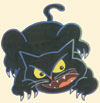|
||||||||||||||||
|
||||||||||||||||
%
responses |
||||||||||||||||
y4 |
y8 |
|||||||||||||||
| Retelling of story: – Tusk was the runt of the litter & was expected to remain small. – Tusk grew into a big, fierce cat. – Tusk became the boss of the home. – Tusk was greedy. – Tusk attacked family members/they used lots of plasters. – Tusk went missing. – Family missed Tusk & looked for Tusk. – Tusk was found with three kittens/had had a family. – The kittens were fierce too - just like Tusk. |
||||||||||||||||
| Number of key points mentioned: |
7–9 |
2 |
18 |
|||||||||||||
6 |
8 |
21 |
||||||||||||||
5 |
14 |
23 |
||||||||||||||
4 |
20 |
21 |
||||||||||||||
3 |
17 |
10 |
||||||||||||||
2 |
19 |
3 |
||||||||||||||
0–1 |
20 |
4 |
||||||||||||||
| Extent to which story was retold
with additional features: |
comprehensively |
3 |
10 |
|||||||||||||
substantially |
14 |
33 |
||||||||||||||
moderately |
33 |
34 |
||||||||||||||
little/not at all |
50 |
23 |
||||||||||||||
| student indicated understanding that Tusk is a female cat 5 14 | ||||||||||||||||
| Coherence of story: (hanging together in logical order; beginning, middle, end; makes sense) |
very high |
3 |
16 |
|||||||||||||
quite high |
17 |
44 |
||||||||||||||
moderate |
34 |
28 |
||||||||||||||
low |
46 |
12 |
||||||||||||||
Total
score: |
10–16 |
8 |
33 |
|||||||||||||
8–9 |
12 |
25 |
||||||||||||||
6–7 |
17 |
24 |
||||||||||||||
4–5 |
22 |
12 |
||||||||||||||
0–3 |
41 |
6 |
||||||||||||||
| Subgroup Analysis [Click on charts to enlarge] : |
| Commentary: |
| This was a difficult reading passage for many year 4 students, particularly Mäori and Pasifika students. Among year 8 students, performance patterns were similar for all five subgroups of students. |
 We’d bang a spoon on the side of the cat food tin, and he’d go racing inside. Then we’d run out, slamming the door behind us. Mostly it worked, but sometimes it didn’t, and I’ve got the scars to prove it.
We’d bang a spoon on the side of the cat food tin, and he’d go racing inside. Then we’d run out, slamming the door behind us. Mostly it worked, but sometimes it didn’t, and I’ve got the scars to prove it.
